Multi-Frequency Differential Absorption LIDAR (DIAL) System for Aerosol and Cloud Retrievals of CO2/H2O and CH4/H2O
Abstract
1. Introduction
2. Experiment
2.1. Combined DIAL and IPDA LIDAR Hardware Description and Line Selection Criteria
2.2. Raw Data Processing and Concentration Fitting Procedure
2.3. Methane Line Shape Profile
3. Results
3.1. IPDA LIDAR Studies of Signal Returns from Diffuse Clouds
3.2. IPDA LIDAR Studies of CO2/H2O and CH4/H2O
3.3. DIAL Studies of CO2/H2O and CH4/H2O and Comparison with the IPDA LIDAR Results
4. Discussion
5. Conclusions and Outlook
Author Contributions
Funding
Data Availability Statement
Acknowledgments
Conflicts of Interest
Appendix A. Atmospheric Profiles from Airport Soundings, Picarro Cavity Ringdown and Vaisala Weather Station Measurements
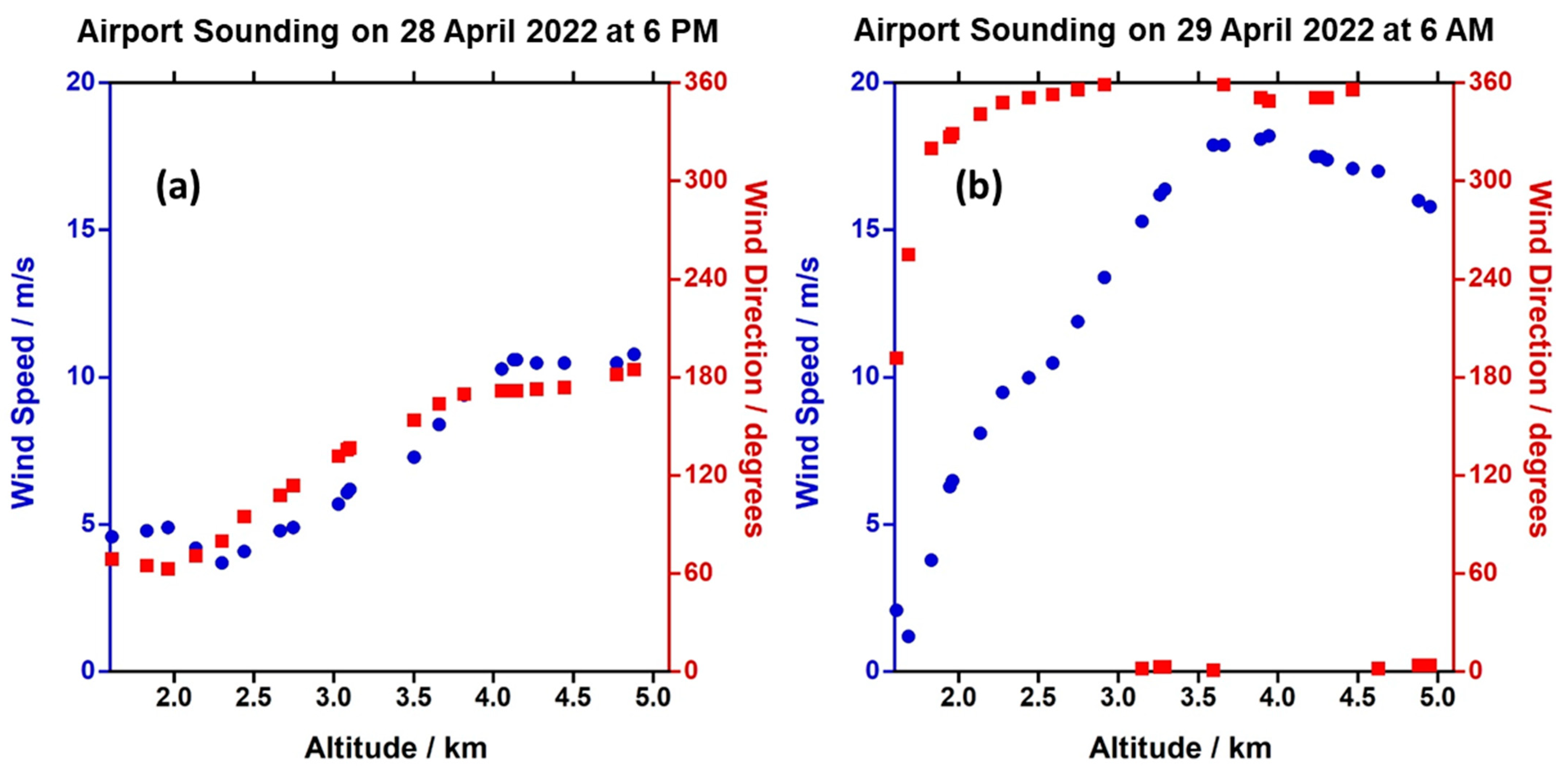

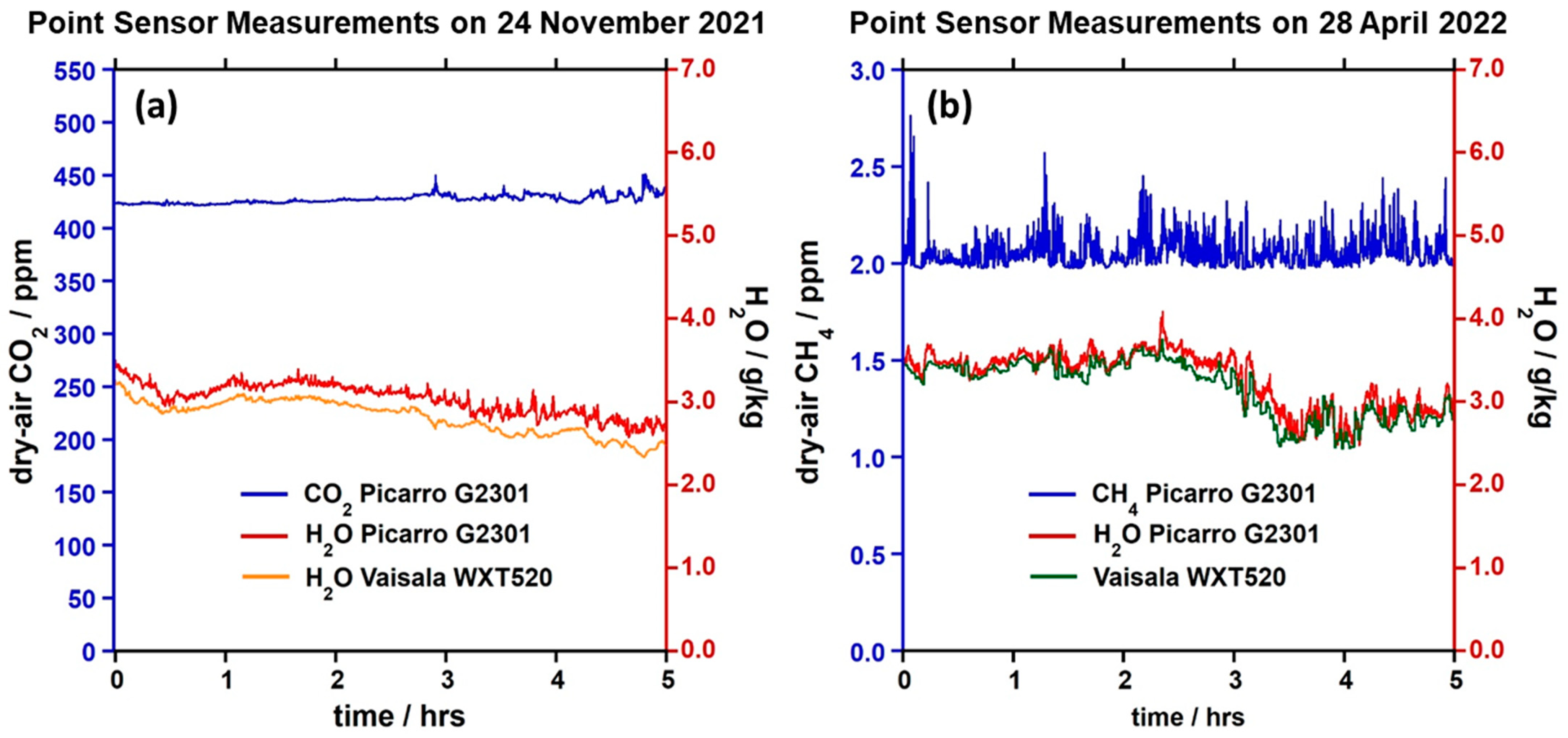
References
- Cezard, N.; Le Mehaute, S.; Le Gouët, J.; Valla, M.; Goular, D.; Fleury, D.; Planchat, C.; Dolfi-Bouteyre, A. Performance assessment of a coherent DIAL-Doppler fiber lidar at 1645 nm for remote sensing of methane and wind. Opt. Express 2020, 28, 22345–22357. [Google Scholar] [CrossRef] [PubMed]
- Koch, G.J.; Beyon, J.Y.; Gibert, F.; Barnes, B.W.; Ismail, S.; Petros, M.; Petzar, P.J.; Yu, J.; Modlin, E.A.; Davis, K.J.; et al. Side-line tunable laser transmitter for differential absorption lidar measurements of CO2: Design and application to atmospheric measurements. Appl. Opt. 2008, 47, 944–956. [Google Scholar] [CrossRef] [PubMed]
- Sakaizawa, D.; Kawakami, S.; Nakajima, M.; Tanaka, T.; Morino, I.; Uchino, O. An airborne amplitude-modulated 1.57 μm differential laser absorption spectrometer: Simultaneous measurement of partial column-averaged dry air mixing ratio of CO2 and target range. Atmos. Meas. Tech. 2013, 6, 387–396. [Google Scholar] [CrossRef]
- Wagner, G.A.; Plusquellic, D.F. Multi-frequency differential absorption LIDAR system for remote sensing of CO2 and H2O near 1.6 µm. Opt. Express 2018, 26, 19420–19434. [Google Scholar] [CrossRef]
- Cadiou, E.; Dherbecourt, J.-B.; Gorju, G.; Melkonian, J.-M.; Godard, A.; Pelon, J.; Raybaut, M. Atmospheric CO2 measurements with a 2-μm DIAL instrument. EPJ Web Conf. 2018, 176, 05045. [Google Scholar] [CrossRef]
- Sakaizawa, D.; Nagasawa, C.; Nagai, T.; Abo, M.; Shibata, Y.; Nakazato, M.; Sakai, T. Development of a 1.6 μm differential absorption lidar with a quasi-phase-matching optical parametric oscillator and photon-counting detector for the vertical CO2 profile. Appl. Opt. 2009, 48, 748. [Google Scholar] [CrossRef] [PubMed]
- Amediek, A.; Fix, A.; Wirth, M.; Ehret, G. Development of an OPO system at 1.57 μm for integrated path DIAL measurement of atmospheric carbon dioxide. Appl. Phys. B 2008, 92, 295–302. [Google Scholar] [CrossRef]
- Ehret, G.; Kiemle, C.; Wirth, M.; Amediek, A.; Fix, A.; Houweling, S. Space-borne remote sensing of CO2, CH4, and N2O by integrated path differential absorption lidar: A sensitivity analysis. Appl. Phys. B 2008, 90, 593–608. [Google Scholar] [CrossRef]
- Abshire, J.B.; Ramanathan, A.K.; Riris, H.; Allan, G.R.; Sun, X.; Hasselbrack, W.E.; Mao, J.; Wu, S.; Chen, J.; Numata, K.; et al. Airborne measurements of CO2 column concentrations made with a pulsed IPDA lidar using a multiple-wavelength-locked laser and HgCdTe APD detector. Atmos. Meas. Tech. 2018, 11, 2001–2025. [Google Scholar] [CrossRef]
- Dobler, J.; Harrison, F.; Browell, E.; Lin, B.; McGregor, D.; Kooi, S.; Choi, Y.; Ismail, S. Atmospheric CO2 column measurements with an airborne intensity-modulated continuous wave 1.57 um fiber laser lidar. Appl. Opt. 2013, 52, 2874–2892. [Google Scholar] [CrossRef]
- Wagner, G.A.; Plusquellic, D.F. Ground-based, integrated path differential absorption LIDAR measurement of CO2, CH4, and H2O near 1.6 μm. Appl. Opt. 2016, 55, 6292–6310. [Google Scholar] [CrossRef] [PubMed]
- Yue, B.; Yu, S.; Li, M.; Wei, T.; Yuan, J.; Zhang, Z.; Dong, J.; Jiang, Y.; Yang, Y.; Gao, Z.; et al. Local-scale horizontal CO2 flux estimation incorporating differential absorption lidar and coherent Doppler wind lidar. Remote Sens. 2022, 14, 5150. [Google Scholar] [CrossRef]
- Stroud, J.R.; Dienstfrey, W.J.; Plusquellic, D.F. Study on local power plant emissions using multi-frequency differential absorption LIDAR and real time plume tracking. Remote Sens. 2023, 15, 4283. [Google Scholar] [CrossRef]
- Amediek, A.; Ehret, G.; Fix, A.; Wirth, M.; Büdenbender, C.; Quatrevalet, M.; Kiemle, C.; Gerbig, C. CHARM-F a new airborne integrated-path differential-absorption lidar for carbon dioxide and methane observations: Measurement performance and quantification of strong point source emissions. Appl. Opt. 2017, 56, 5182–5197. [Google Scholar] [CrossRef] [PubMed]
- Riris, H.; Numata, K.; Li, S.; Wu, S.; Ramanathan, A.; Dawsey, M.; Mao, J.; Kawa, R.; Abshire, J.B. Airborne measurements of atmospheric methane column abundance using a pulsed integrated-path differential absorption lidar. Appl. Opt. 2012, 51, 8296–8306. [Google Scholar] [CrossRef] [PubMed]
- Ehret, G.; Bousquet, P.; Pierangelo, C.; Alpers, M.; Millet, B.; Abshire, J.B.; Bovensmann, H.; Burrows, J.P.; Chevallier, F.; Ciais, P.; et al. MERLIN: A French-German space lidar mission dedicated to atmospheric methane. Remote Sens. 2017, 9, 1052. [Google Scholar] [CrossRef]
- Bode, M.; Alpers, M.; Millet, B.; Ehret, G.; Flamant, P. MERLIN: An integrated path differential absorption (IPDA) LIDAR for global methane remote sensing. In Proceedings of the International Conference on Space Optics (ICSO), Tenerife, Spain, 7–10 October 2014. [Google Scholar]
- Mao, J.; Ramanathan, A.; Abshire, J.B.; Kawa, S.R.; Riris, H.; Allan, G.R.; Rodriguez, M.; Hasselbrack, W.E.; Sun, X.; Numata, K.; et al. Measurement of atmospheric CO2 column concentrations to cloud tops with a pulsed multi-wavelength airborne lidar. Atmos. Meas. Tech. 2018, 11, 127–140. [Google Scholar] [CrossRef]
- Durand, Y.; Caron, J.; Bensi, P.; Ingmann, P.; Bézy, J.; Meynart, R. A-SCOPE: Concepts for an ESA mission to measure CO2 from space with a lidar. In Proceedings of the 8th International Symposium on Tropospheric Profiling, Delft, The Netherlands, 19–23 October 2009. [Google Scholar]
- Bousquet, P.; Pierangelo, C.; Bacour, C.; Marshall, J.; Peylin, P.; Ayar, P.V.; Ehret, G.; Bréon, F.-M.; Chevallier, F.; Crevoisier, C.; et al. Error budget of the Methane Remote LIdar missioN and its impact on the uncertainties of the global methane budget. J. Geophys. Res. Atmos. 2018, 123, 11766–11785. [Google Scholar] [CrossRef]
- Petros, M.; Refaat, T.F.; Singh, U.N.; Yu, J.; Antill, C.; Remus, R.; Taylor, B.D.; Wong, T.-H.; Reithmaier, K.; Lee, J.; et al. Development of an advanced two-micron triple-pulse IPDA LIDAR for carbon dioxide and water vapor measurements. EPJ Web Conf. 2018, 176, 01009. [Google Scholar] [CrossRef][Green Version]
- Stroud, J.R.; Wagner, G.A.; Plusquellic, D.F. Validation of a Multi-Frequency Differential Absorption LIDAR (DIAL) System from Aerosol and Cloud Retrievals. Paper JW3A.18; CLEO: San Jose, CA, USA, 2022. [Google Scholar]
- Wagner, G.; Behrendt, A.; Wulfmeyer, V.; Späth, F.; Schiller, M. High-power Ti:sapphire laser at 820 nm for scanning ground-based water–vapor differential absorption lidar. Appl. Opt. 2013, 52, 2454–2469. [Google Scholar] [CrossRef]
- Certain commercial equipment, instruments, or materials are identified in this paper in order to specify the experimental procedure adequately. Such identification is not intended to imply recommendation or endorsement by NIST, nor is it intended to imply that the materials or equipment identified are necessarily the best available for the purpose.
- Drever, R.W.P.; Hall, J.L.; Kowalski, F.V.; Hough, J.; Ford, G.M.; Munley, A.J.; Ward, H. Laser phase and frequency stabilization using an optical resonator. Appl. Phys. B Laser Opt. 1983, 31, 97–105. [Google Scholar] [CrossRef]
- Delahaye, T.; Maxwell, S.E.; Reed, Z.D.; Lin, H.; Hodges, J.T.; Sung, K.; Devi, V.M.; Warneke, T.; Spietz, P.; Tran, H. Precise methane absorption measurements in the 1.64 μm spectral region for the MERLIN mission. J. Geophys. Res. Atmos. 2016, 121, 7360–7370. [Google Scholar] [CrossRef] [PubMed]
- Vasilchenko, S.; Delahaye, T.; Kassi, S.; Campargue, A.; Armante, R.; Tran, H.; Mondelain, D. Temperature dependence of the absorption of the R(6) manifold of the 2 ν3 band of methane in air in support of the MERLIN mission. J. Quant. Spectrosc. Radiat. Transf. 2023, 298, 108483. [Google Scholar] [CrossRef]
- Plusquellic, D.F.; Votava, O.; Nesbitt, D.J. Absolute frequency stabilization of an injection-seeded optical parametric oscillator. Appl. Opt. 1996, 35, 1464–1472. [Google Scholar] [CrossRef] [PubMed]
- Newsom, R.K.; Turner, D.D.; Mielke, B.; Clayton, M.; Ferrare, R.; Sivaraman, C. Simultaneous analog and photon counting detection for Raman lidar. Appl. Opt. 2009, 48, 3903–3914. [Google Scholar] [CrossRef]
- Mendonca, J.; Strong, K.; Wunch, D.; Toon, G.C.; Long, D.A.; Hodges, J.T.; Sironneau, V.T.; Franklin, J.E. Using a speed-dependent Voigt line shape to retrieve O2 from Total Carbon Column Observing Network solar spectra to improve measurements of XCO2. Atmos. Meas. Tech. 2019, 12, 35–50. [Google Scholar] [CrossRef]
- Gordon, I.; Rothman, L.; Hargreaves, R.; Hashemi, R.; Karlovets, E.; Skinner, F.; Conway, E.; Hill, C.; Kochanov, R.; Tan, Y.; et al. The HITRAN2020 Molecular spectroscopic database. J. Quant. Spectrosc. Radiat. Transf. 2022, 277, 107949. [Google Scholar] [CrossRef]
- NOAA; NASA; USAF. U.S. Standard Atmosphere. 1976. Available online: https://www.ngdc.noaa.gov/stp/space-weather/online-publications/miscellaneous/us-standard-atmosphere-1976/us-standard-atmosphere_st76-1562_noaa.pdf (accessed on 28 November 2023).
- Gotti, R.; Prevedelli, M.; Kassi, S.; Marangoni, M.; Romanini, D. Feed-forward coherent link from a comb to a diode laser: Application to widely tunable cavity ring-down spectroscopy. J. Chem. Phys. 2018, 148, 054202. [Google Scholar] [CrossRef]
- Vasilchenko, S.; Tran, H.; Mondelain, D.; Kassi, S.; Campargue, A. Accurate absorption spectroscopy of water vapor near 1.64 μm in support of the MEthane Remote LIdar missioN (MERLIN). J. Quant. Spectrosc. Radiat. Transf. 2019, 235, 332–342. [Google Scholar] [CrossRef]
- Ngo, N.; Lisak, D.; Tran, H.; Hartmann, J.-M. An isolated line-shape model to go beyond the Voigt profile in spectroscopic databases and radiative transfer codes. J. Quant. Spectrosc. Radiat. Transf. 2013, 129, 89–100. [Google Scholar] [CrossRef]
- Fix, A.; Quatrevalet, M.; Amediek, A.; Wirth, M. Energy calibration of integrated path differential absorption lidars. Appl. Opt. 2018, 57, 7501–7514. [Google Scholar] [CrossRef] [PubMed]
- Sun, X.; Abshire, J.B.; Ramanathan, A.; Kawa, S.R.; Mao, J. Retrieval algorithm for the column CO2 mixing ratio from pulsed multi-wavelength lidar measurements. Atmos. Meas. Tech. 2021, 14, 3909–3922. [Google Scholar] [CrossRef]
- Clough, S.A.; Iacono, M.J. Line-by-line calculation of atmospheric fluxes and cooling rates 2. Application to carbon dioxide, methane, nitrous oxide and the halocarbons. J. Geophys. Res. Atmos. 1995, 100, 16519–16535. [Google Scholar] [CrossRef]
- Delahaye, T.; Landsheere, X.; Pangui, E.; Huet, F.; Hartmann, J.-M.; Tran, H. Mesaurements of H2O broadening coefficients of infrared methane lines. J. Quant. Spectrosc. Radiat. Transf. 2016, 173, 40–48. [Google Scholar] [CrossRef]
- Cole, R.; Fredrick, C.; Nguyen, N.H.; Diddams, S.A. Precision Doppler shift measurements with a frequency comb calibrated laser heterodyne radiometer. Opt. Lett. 2023, 48, 5185–5188. [Google Scholar] [CrossRef]
- Agustí-Panareda, A.; Barré, J.; Massart, S.; Inness, A.; Aben, I.; Ades, M.; Baier, B.C.; Balsamo, G.; Borsdorff, T.; Bousserez, N.; et al. Technical note: The CAMS greenhouse gas reanalysis from 2003 to 2020. Atmos. Chem. Phys. 2023, 23, 3829–3859. [Google Scholar] [CrossRef]
- Stroud, J.R.; Simon, J.R.; Wagner, G.A.; Plusquellic, D.F. Interleaved electro-optic dual comb generation to expand bandwidth and scan rate for molecular spectroscopy and dynamics studies near 1.6 μm. Opt. Express 2021, 29, 33155–33170. [Google Scholar] [CrossRef]
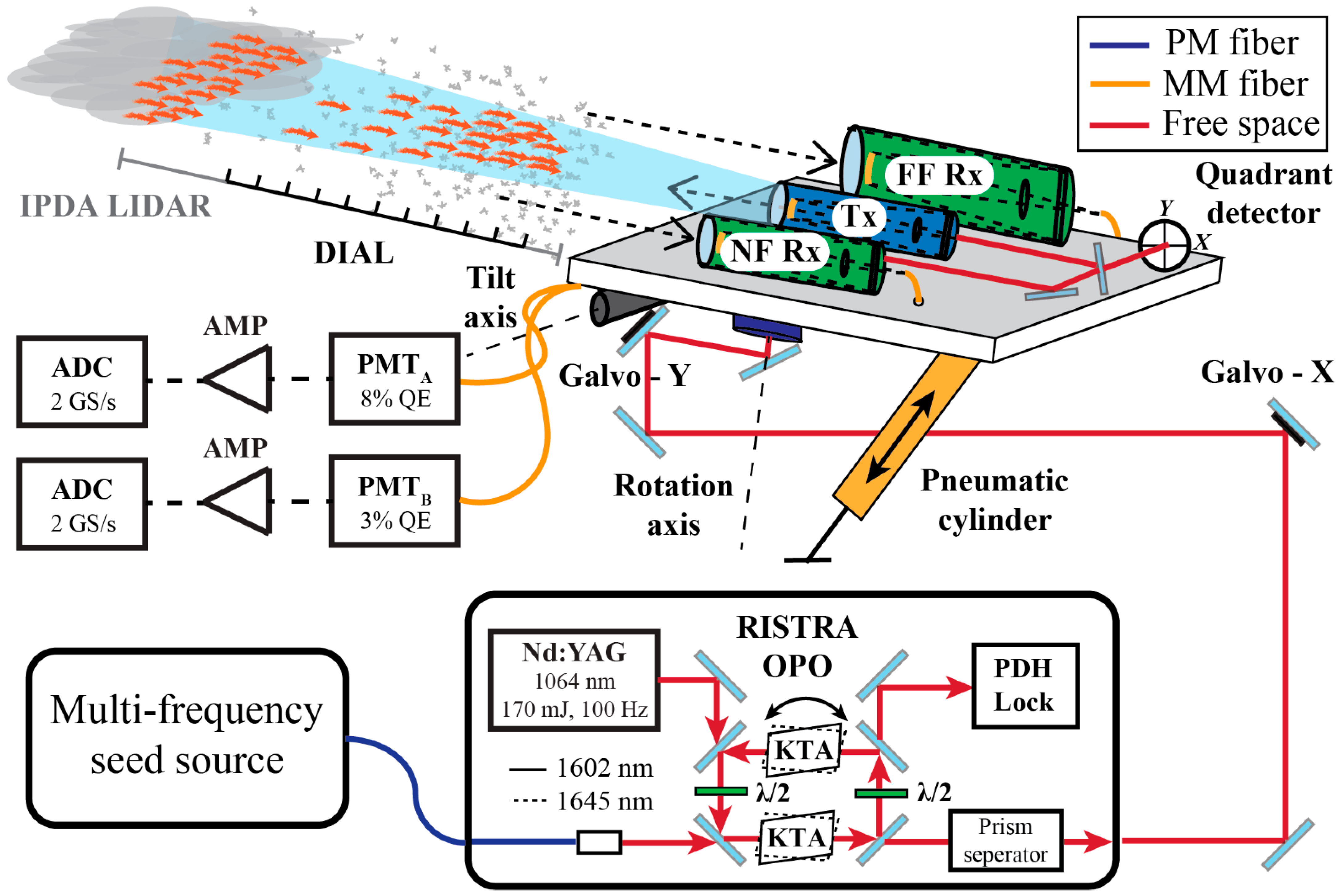
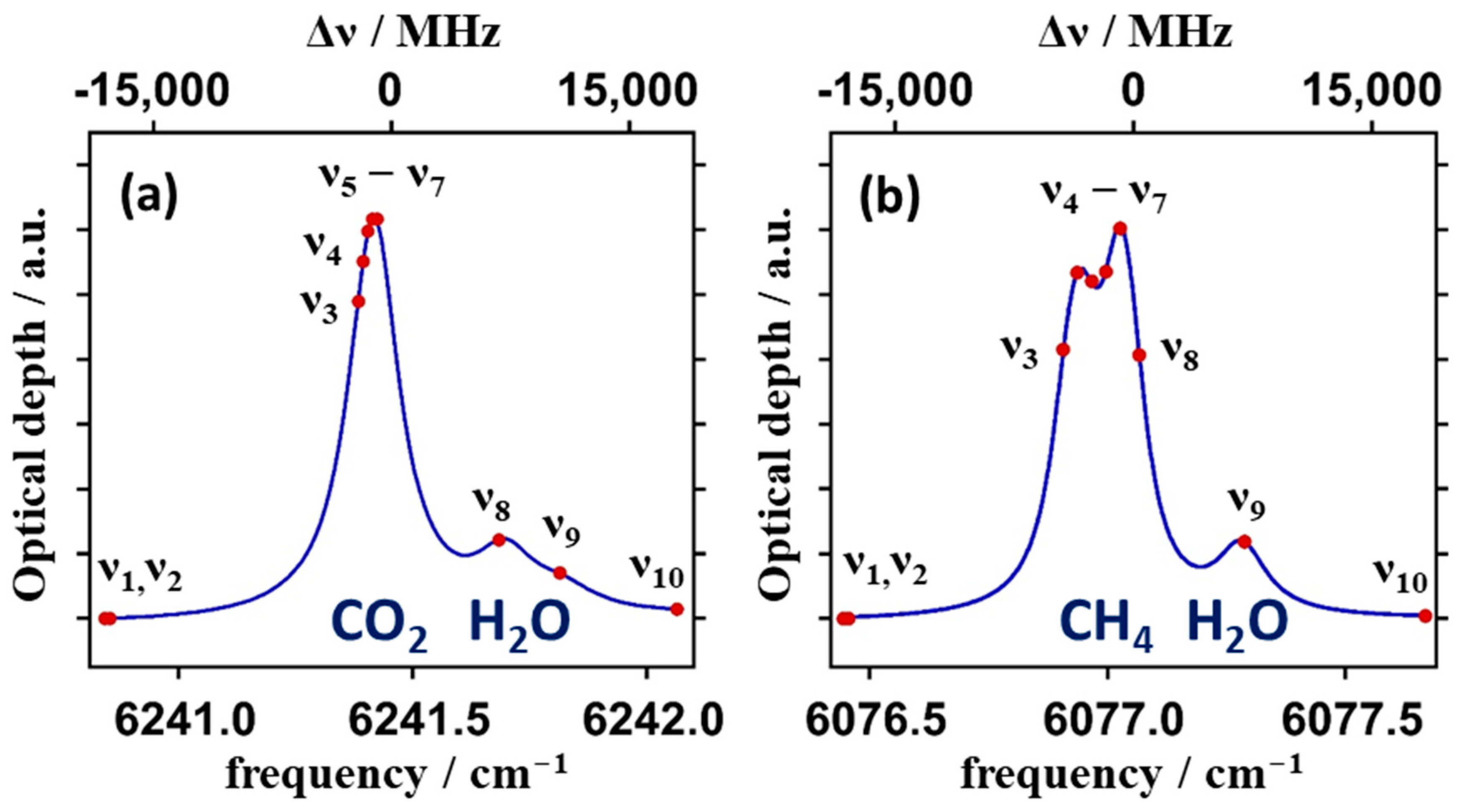
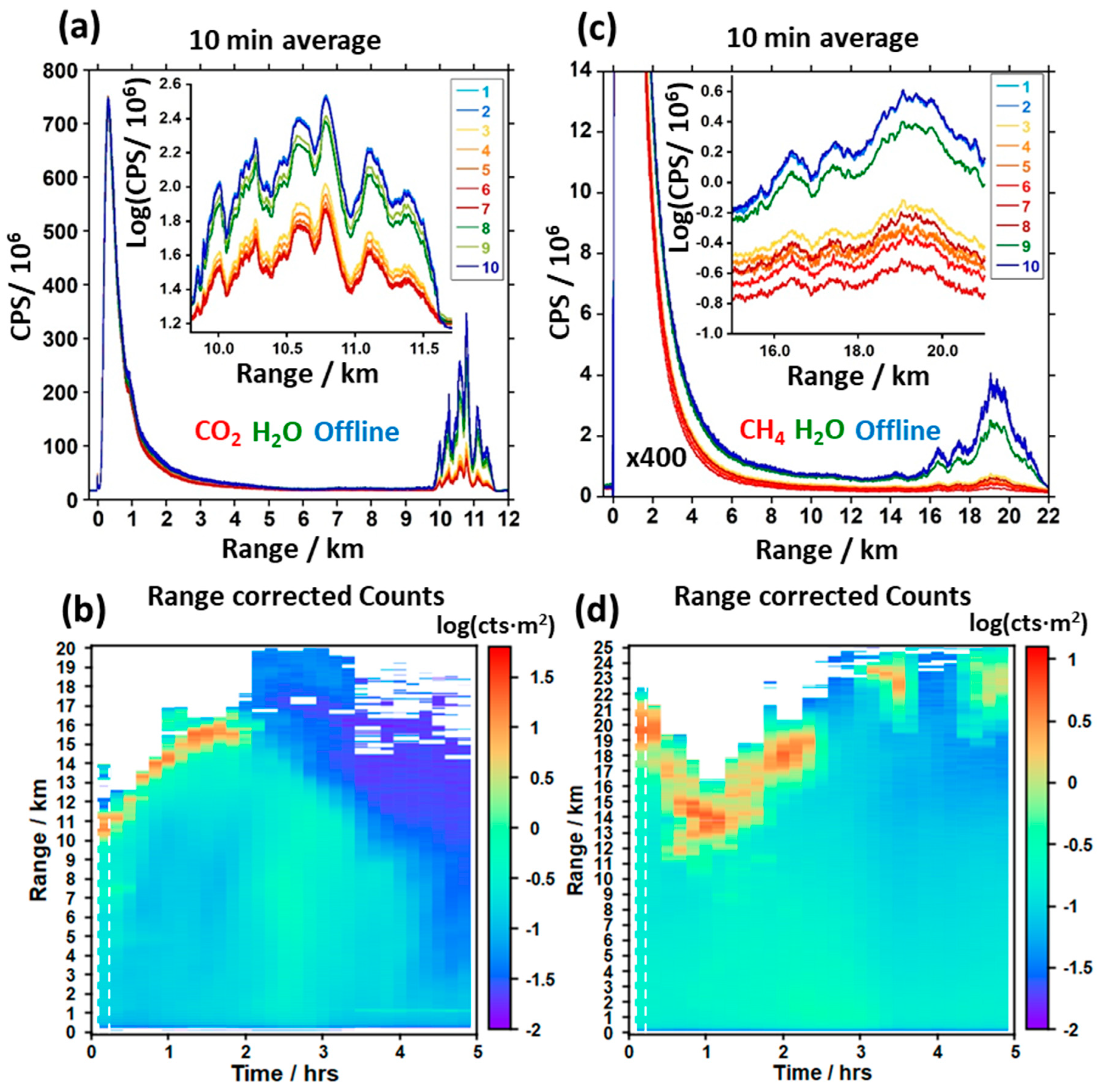
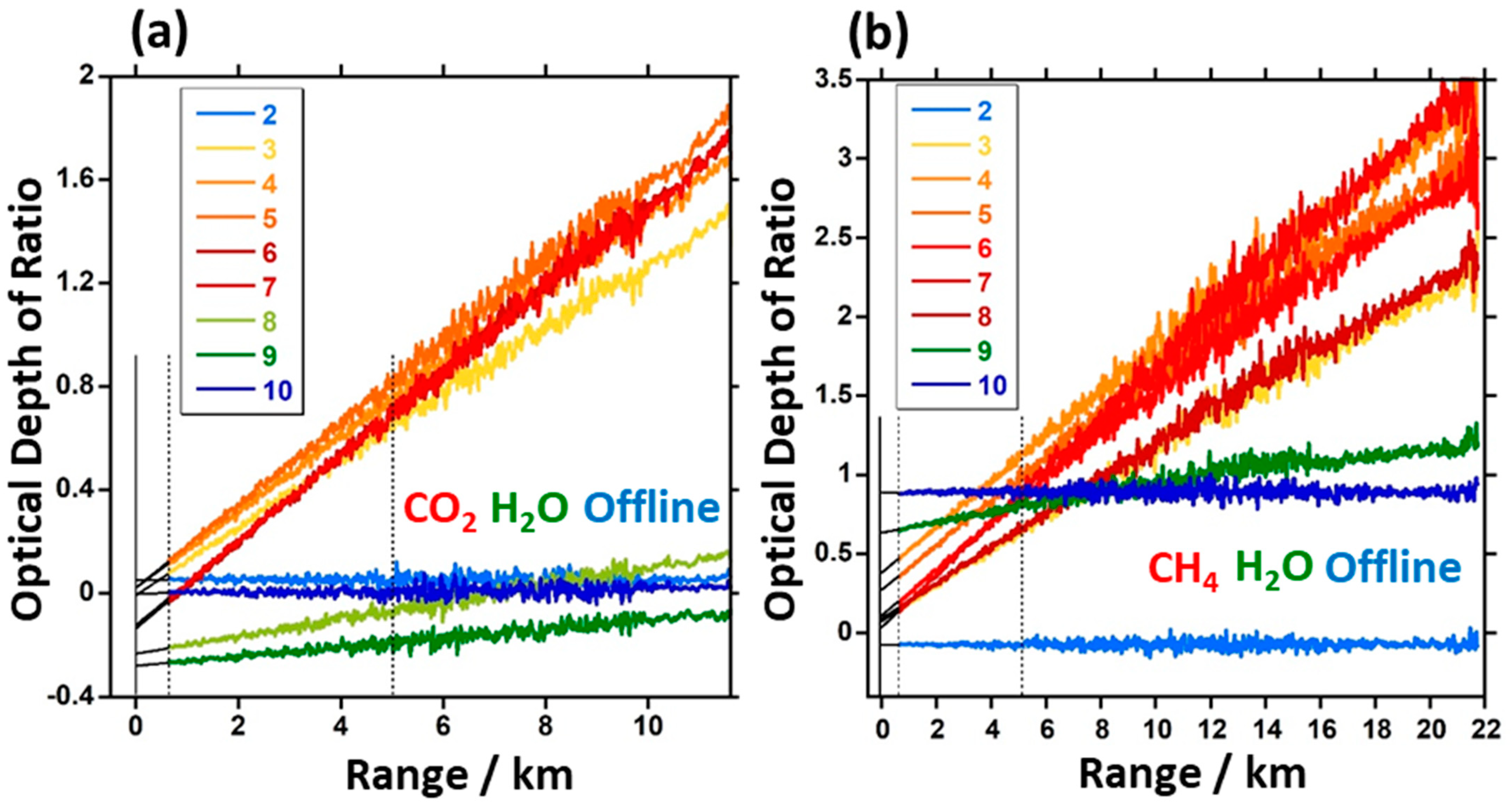
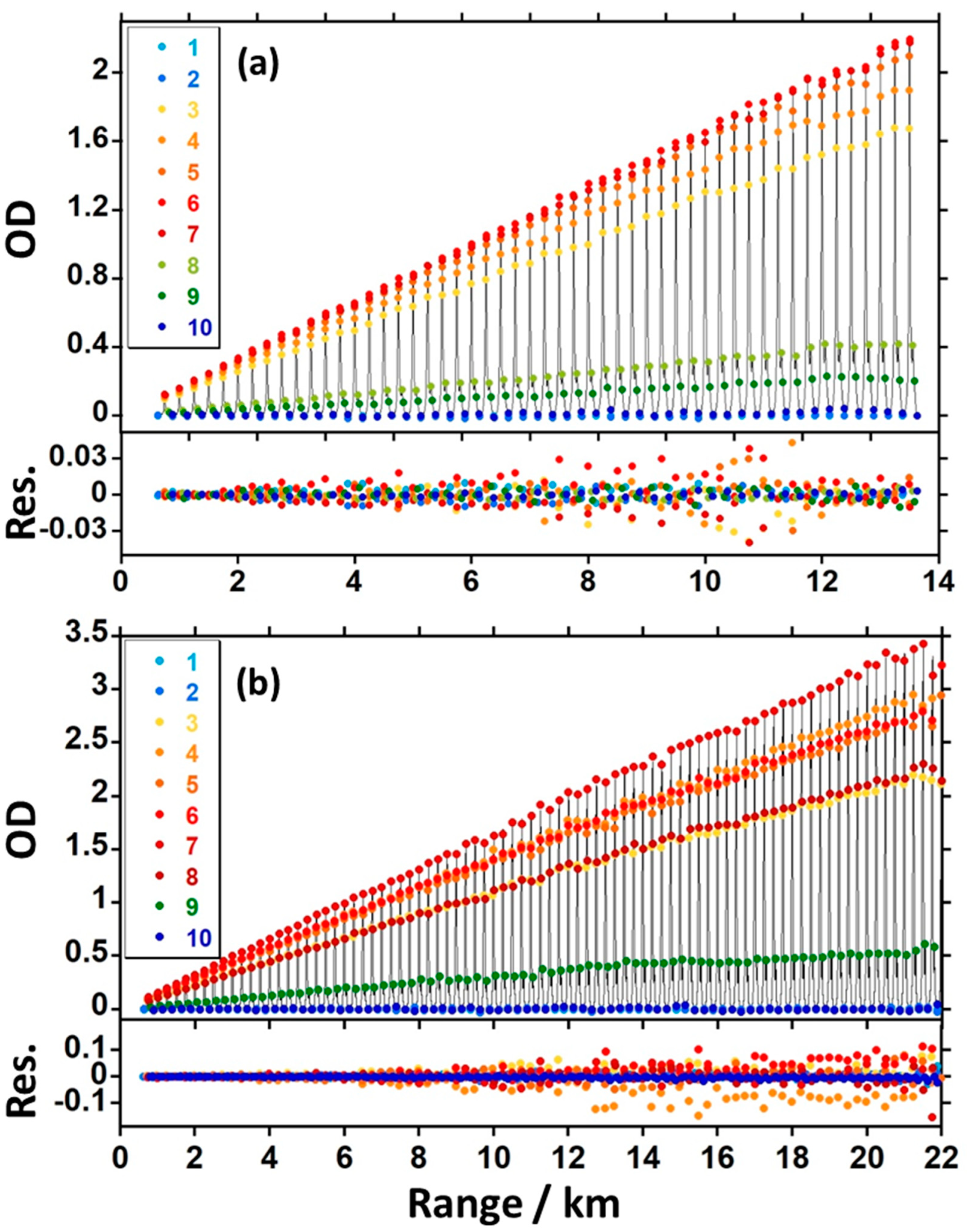


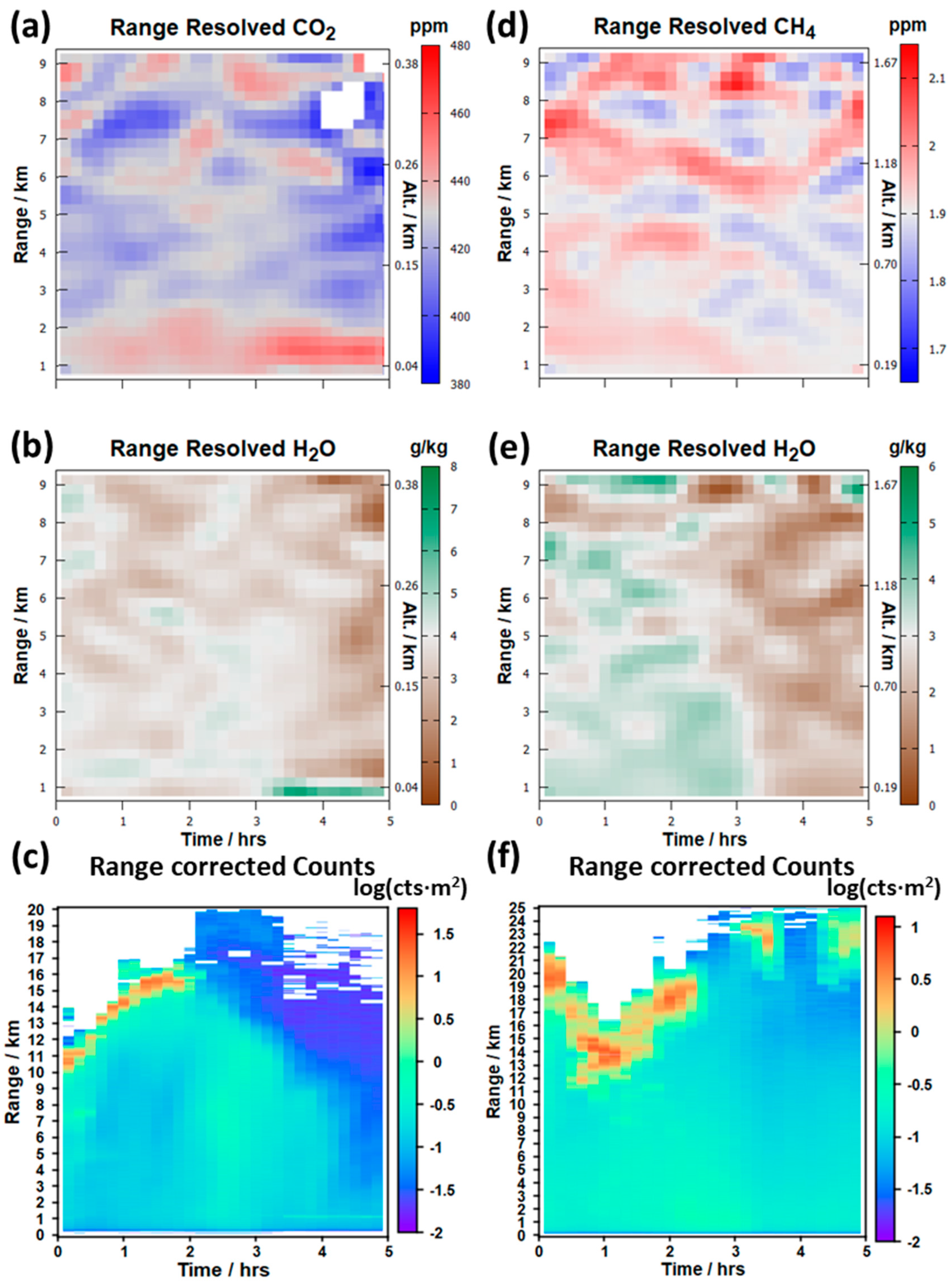

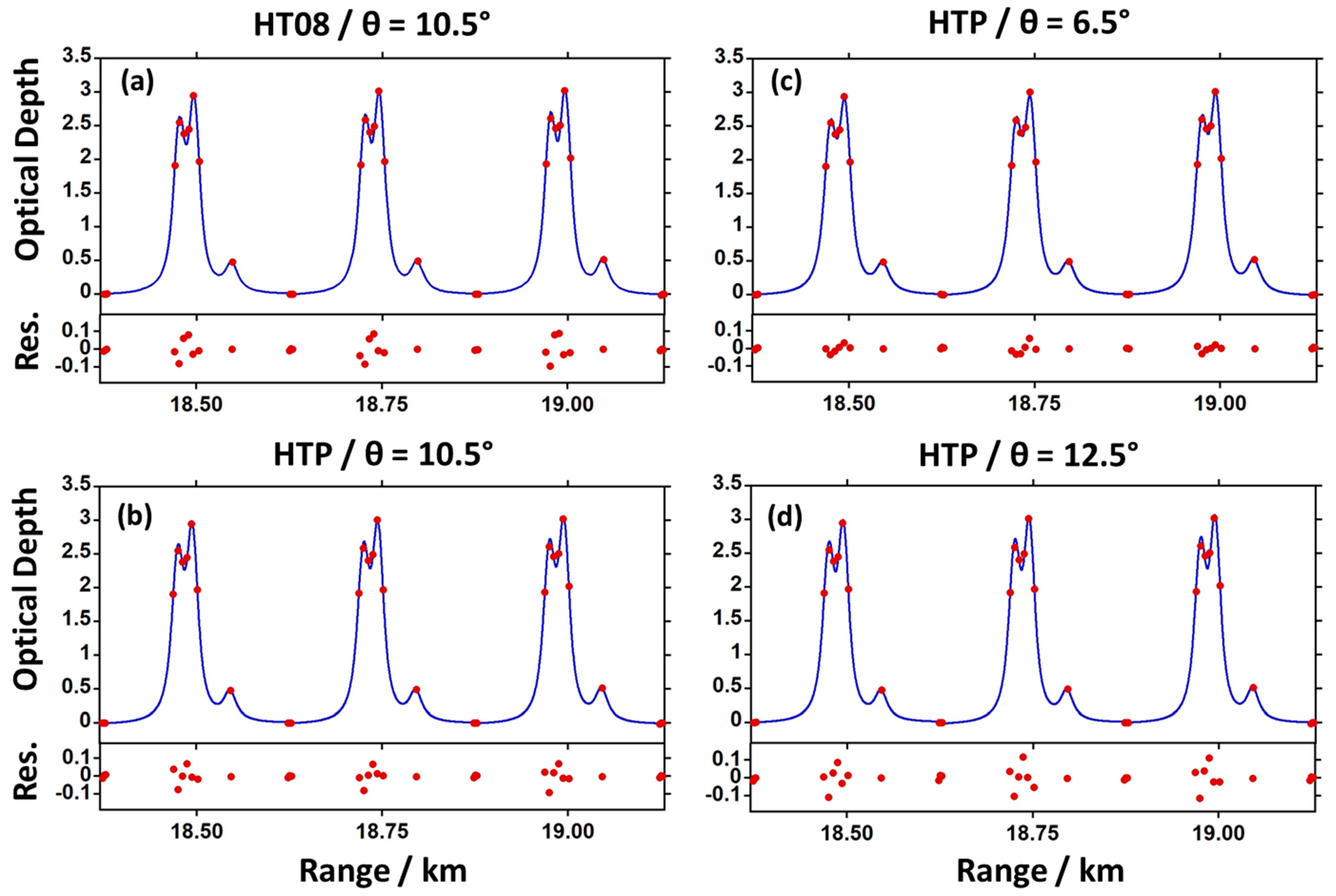
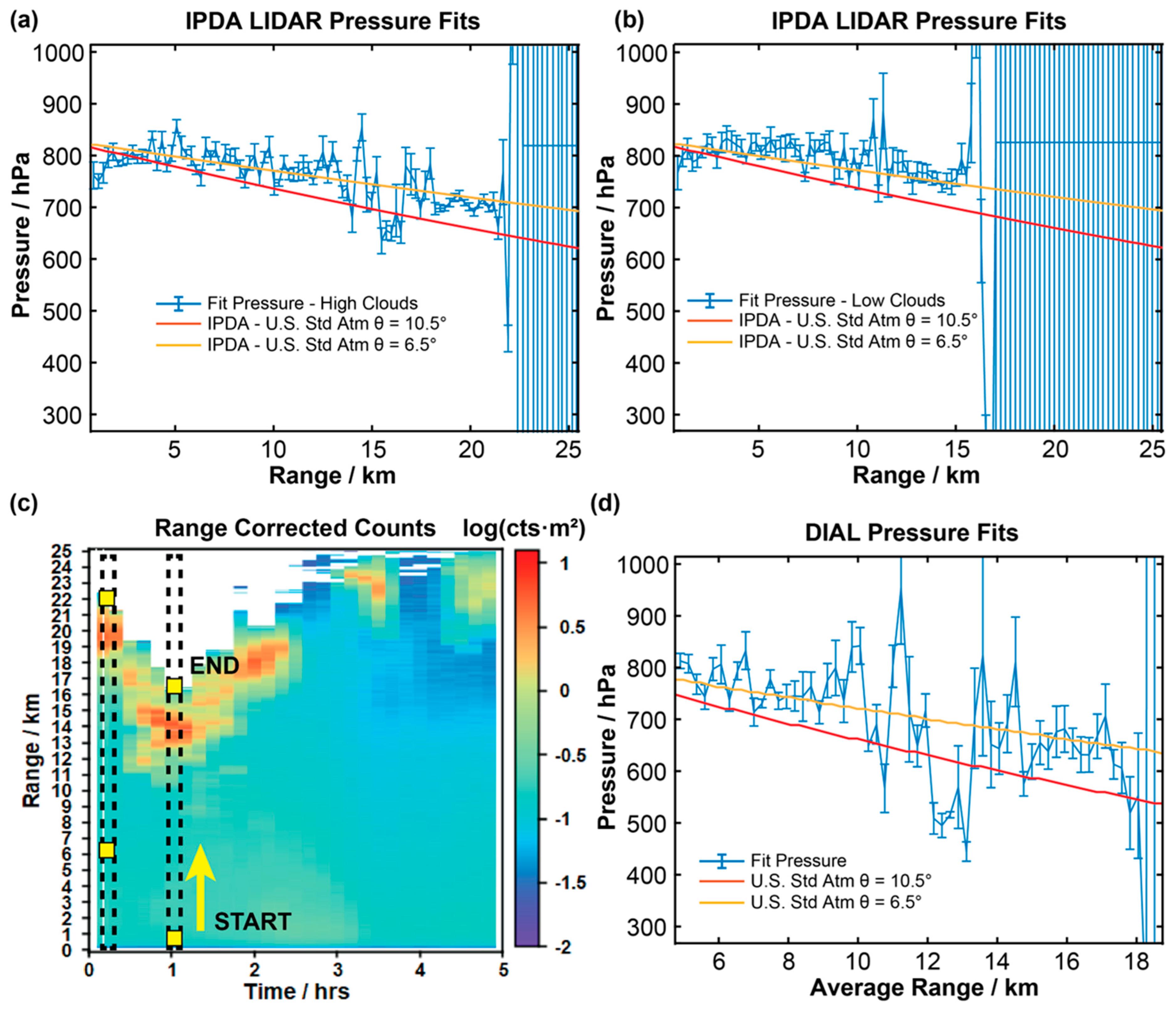
| Frequency Converter | Parameters | Description/Manufacturer |
|---|---|---|
| Wavelength coverage | 1600 nm to 1647 nm | New Focus, ECDL |
| Number of frequencies | 10 | Spectral coverage ≈ 40 GHz |
| PRF, SRF | 100 Hz, 10 Hz | - |
| Microwave Synthesizer | 20 GHz bandwidth | Anritsu, MG37022A |
| Pulse energy | 5 mJ signal wave | Ep ≈ 170 mJ, Coherent Infinity |
| Pulse length (FWHM) | <3 ns | Pump pulse ≈ 3 ns FWHM |
| Spectral linewidth (FWHM) | 190 MHz | Nearly transform limited |
| Two OPO KTA Crystals | 10 × 10 × 15 mm3, θ = 67.4°, φ = 0° | Optical Platz, Inc. (NM, USA) |
| OPO | RISTRA, twisted rectangle | AS Photonics, Inc. (Albuquerque, MN, USA) |
| Telescopes and detectors | ||
| Tx beam diameter, divergence | 254 mm, <300 to 400 μrad | Ritchey-Chrétien, Orion |
| NF Rx. diameter, FOV | 279.4 mm, 3 mrad | Schmidt-Cassegrain, Celestron |
| FF Rx. diameter, FOV | 406.5 mm, 2 mrad | Schmidt-Cassegrain, Meade |
| Bandpass filter, 1645.5 nm | 1.9 nm (FWHM), T > 90% | >5 OD rejection, Alluxa |
| Bandpass filter, 1602.2 nm | 2.0 nm (FWHM), T > 90% | >5 OD rejection, Materion |
| Neutral density filter | 0.1, 0.3, 0.6, and 1 OD | Thorlabs |
| Rx to PMT fiber core diameters | 1 mm | 1 m cable length |
| NF PMT | ~3% QE | Hamamatsu H12397-75 |
| FF PMT | ~8% QE | Hamamatsu H12397-75 SEL |
| Data acquisition | ||
| Transimpedance amp | 5 kV/A, τ3dB ≈ 1 ns | Femto HCA-400M-5K-C |
| Digitizer | 8 bits, 2 GS/s, 2 channels | GaGe CobraMax CSE24G8 |
| Raw data storage | 10 s average | NetCDF4 file format |
| Range bin resolution | 250 m to 500 m | Defined in post-processing |
| Temporal resolution | 10 min | DIAL concentration average |
Disclaimer/Publisher’s Note: The statements, opinions and data contained in all publications are solely those of the individual author(s) and contributor(s) and not of MDPI and/or the editor(s). MDPI and/or the editor(s) disclaim responsibility for any injury to people or property resulting from any ideas, methods, instructions or products referred to in the content. |
© 2023 by the authors. Licensee MDPI, Basel, Switzerland. This article is an open access article distributed under the terms and conditions of the Creative Commons Attribution (CC BY) license (https://creativecommons.org/licenses/by/4.0/).
Share and Cite
Stroud, J.R.; Wagner, G.A.; Plusquellic, D.F. Multi-Frequency Differential Absorption LIDAR (DIAL) System for Aerosol and Cloud Retrievals of CO2/H2O and CH4/H2O. Remote Sens. 2023, 15, 5595. https://doi.org/10.3390/rs15235595
Stroud JR, Wagner GA, Plusquellic DF. Multi-Frequency Differential Absorption LIDAR (DIAL) System for Aerosol and Cloud Retrievals of CO2/H2O and CH4/H2O. Remote Sensing. 2023; 15(23):5595. https://doi.org/10.3390/rs15235595
Chicago/Turabian StyleStroud, Jasper R., Gerd A. Wagner, and David F. Plusquellic. 2023. "Multi-Frequency Differential Absorption LIDAR (DIAL) System for Aerosol and Cloud Retrievals of CO2/H2O and CH4/H2O" Remote Sensing 15, no. 23: 5595. https://doi.org/10.3390/rs15235595
APA StyleStroud, J. R., Wagner, G. A., & Plusquellic, D. F. (2023). Multi-Frequency Differential Absorption LIDAR (DIAL) System for Aerosol and Cloud Retrievals of CO2/H2O and CH4/H2O. Remote Sensing, 15(23), 5595. https://doi.org/10.3390/rs15235595







